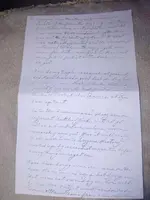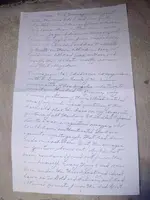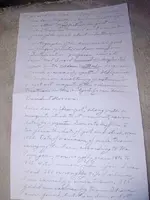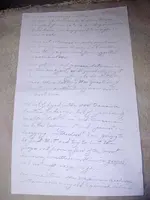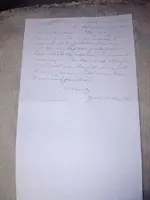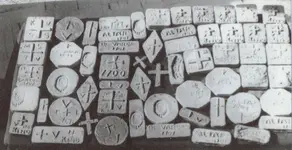gollum
Gold Member
- Joined
- Jan 2, 2006
- Messages
- 6,770
- Reaction score
- 7,734
- Golden Thread
- 0
- Location
- Arizona Vagrant
- Detector(s) used
- Minelab SD2200D (Modded)/ Whites GMT 24k / Fisher FX-3 / Fisher Gold Bug II / Fisher Gemini / Schiebel MIMID / Falcon MD-20
- Primary Interest:
- All Treasure Hunting
- #1
Thread Owner
As the title suggests, using much conventional wisdom, the items mentioned in this thread should not exist!
The Church, The Society of Jesus (Jesuits), and historians like the eminent (and late) Father Charles Polzer SJ (Jesuit), all state without equivocation that the Jesuits' in Primeria Alta NEVER operated any mines. They NEVER owned any Silver or Gold (except what they got in trade for goods and services from the farms, or cattle the missions DID operate). They state that the Jesuits' main purpose for being in Pimeria Alta was to convert the local Indian Populaces to Catholicism.
Is it true?
To some, NO! To others, ABSOLUTELY? It's sort of like Peg Leg's Black Gold Nuggets. There are a lot of people who have heard of them, and many more people who haven't, and there are many who have heard about them, but don't really know any of the details. There have been people murdered over those blackened gold nuggets. I have seen countless articles that state absolutely that the stories told by Old Peg Leg were just more of his tall tales (and he was well known for telling whoppers). Then in the mid 1960s, these turn up:

All the debate over whether or not they exist, now suddenly changes to "Where are they?" and "Where did they come from?"
Same thing with some Gold/Silver Alloyed Ingots (bars). A few years ago, I saw a picture (there was only one) of two "Silver Trade Bars" that were displayed in some museum (turned out to be The Arizona Mining and Minerals Museum). The card with them said they were on loan from a Ray Kopman. I searched everywhere I could find for a Ray Kopman. No Luck! I searched for any references to those "Silver Trade Bars". No Luck! I had pretty much given up hope on finding out anything more than they existed in one little picture.
Then, a few days ago, I was contacted on another forum by the current owner who asked me if I would be interested in acting as a broker, and trying to sell them for him. Needless to say, I said YES! I asked for whatever history he had on the bars, and better pictures. He provided both. For anybody who has seen the old picture of them, they look NOTHING like that! Funny thing about photographs.
Here is the old photograph:

Turns out, that after speaking with the current owner, that these are not just Silver. They are 60% Silver, and 40% Gold (remember this fact as it will come back into play later). Here are better pictures of them:
The Kino Bar weighs 72.1 Grams, and measures 61mm x 25mm x 5mm

The Altar Bar weighs 72.7 Grams, and measures 41mm x 36mm x 5mm

I think that these two bars are historically significant, in that they represent something that according to many people should not exist. So, not only will I see about selling them for the owner, I think their story should be told as well.
Jesuit Mines?
Let's start with a quote from Professor W. Wrightson who was the General Agent for the Aztec Syndicate Mining Group. He was exploring the Santa Cruz River Valley looking for good mining sites. Now, I would think that a Mining Syndicate General Agent would be pretty well versed in most all aspects of mining operations. Pretty obvious to me. Let's hear what he says about one of the things he found when he visited the Mission at Tumacacori in 1860 (it was long abandoned by then):
Furnaces with slag are not indicative of lime or brick burning pits as stated by the NPS (National Park Service).
This quote is taken directly from the National Park Service Website on the Tumacacori Mission. You can read the full article here:
http://www.nps.gov/history/history/online_books/pinkley/pinkley_tuma/sec1.htm
Interesting huh?
Both Padre Kino's and Manje's Diaries speak of visiting mines. They don't specify Mission or Spanish. There were a rash of Indian Revolts over the years, due to the Indians mistreatment at the hands of their new Lords.
Back to the story of these two bars:
According to the owner (An Engineer for the Boeing Corporation), when Padre Kino died in 1711, these bars were given to a Yaqui Family. They kept them until approximately 1947, when the last member of that family (a man named Donkey), sold them to a white man he befriended named Ray KAPLAN (not Kopman, that's why I couldn't find anything out about him). They remained property of Ray Kaplan, and were displayed off and on in the Az. Mining & Minerals Museum as "Silver Trade Bars" (even though they contain 40% Gold) from 1947 until 2004, when Ray and the Museum Director assigned ownership to the current owner.
He (owner) states that many people have tried to buy the bars over the years, but Kaplan refused to sell, because the story from the Yaqui man was that these were actually the personal property of Padre Kino. True? Who knows. Do Kino's diaries say anything specific about owning these two, or any bars like this? Not that I know of. The owner has spent the last twenty-five years researching both Kino and these bars (Kaplan was a long time family friend). It appears that the Smithsonian owns a set of bars like these, but they are dated 1707.
Now, I suppose we need to get back to the subject of whether or not the Jesuits operated any mines in Pimeria Alta.
It is a well known fact that the Jesuits TAUGHT MINING SCHOOLS in the New World. Now, if the Jesuits stuck by the letter of the law (according to Charles III, they were not allowed to mine), they would not have owned or operated any mines. We know the Jesuits wouldn't do anything against the King's Laws would they? Why did they get expelled from the New World. Some say because of something the Jesuits were doing in Europe. One person says it was because they were going to assist the Dutch in taking the New World from Spain. Others say it was because the Jesuits were becoming too powerful and wealthy. They had the loyalty of the Indians (at that time), and wealth that made Spanish Governors jealous. Were they just expelled? Did the King just send a letter saying "Get OUT!"? NOPE! King Charles III in 1767 sent an Envoy to SECRETLY gather up all the Jesuit Priests and put them on a ship back to Europe.
Now, let's look at this a little closer. Why would the King want the priests' roundup to be kept a secret? Doesn't really make a lot of sense on the surface, if you believe that they had no mines. If the Jesuits were poor, what would be the need for secrecy? They couldn't run anywhere. They weren't being executed. Just kicked out of the New World, and sent home. Why the secrecy? No sense at all, UNLESS....................
You imagine for a moment that the Jesuits had mines in the far North of Pimeria Alta. Mines that were in direct conflict with what the King had ordered. Seems to me the only SENSIBLE reason to keep the Jesuit Roundups a secret, would be to grab them before they had a chance to hide something, or run away. As I have stated previously: They were not being executed, just shipped home. No reason to run there. Where would they run to? Further North, into the desert? Not likely. Once again, NO EXECUTIONS, just going home to Europe. Now, let's look at what they had to hide. Crops? Cattle? Converts? Those were all within their charter from the King. Nothing to hide there. Mines? Goes against the Kings Charter to the Jesuits. Large Scale mining operations, and none of the money going to the Crown would be a VERY GOOD reason to keep the Jesuit Roundups a secret. This way, the Spanish could catch the Jesuits before they had time to hide evidence of their mining operations. The King (after receiving reports of Jesuit mines), wanted to catch them with their pants down (so to speak). That is the ONLY good explanation I have ever heard for King Charles III to keep the rounding up of Jesuit Priests a secret. Only problem was, the Indians liked the Jesuits more than they did the Spanish. When they saw the roundups in the Port Cities, they quickly sent word to the Missions farther inland. This resulted in the Padres in Pimeria Alta Inland Areas getting about a six week forewarning. Plenty of time to backfill and bury mines.
Now, let's look at other reported findings of Jesuit Treasure:
In the late 1930s, a man named Milton Rose supposedly found a Spanish Mine right near the border West of Nogales, Az. Here are B&W Pics of some of the 800 or so bars of Silver, Gold, and Silver-Gold Alloy (and this alloy was only about 40% Gold).




In the 1980s a man (let's call him Ron) and three friends found a total of 187 pounds of Gold Bars in roughly the same area. Due to his picture being shown in Treasure Magazine holding the bars, somebody dropped a dime on him to the IRS, and he lost it all (except the pics):





Now, let's look at some common factors in ALL the bars:
>The Jesuit Cross and "V". This would denote that it belonged to the Jesuit Order.
>Some of the bars have the cross above a circle. This is the Spanish map Symbol for a mission
>Shapes. Most of the bars are small square and rectangular in shape. Some of the bars from Rose's mine were bar shaped, and stamped or had symbols cast into the ends.
THE ALTAR BAR:
The ALTAR Mission was in between The Tubutama Mission and the Oquitoa Mission at the end of the ALTAR River. That is the meaning of the TWO mission symbols (cross over circle) on the bar. The "X" marks the spot of the ALTAR Mission (between Tubutama and Oquitoa Missions). The word peseta (meaning little piece) most likely does not refer to the Spanish Monetary Unit PESETA. Most likely, since the Jesuit Bars come in two sizes (rectangular and square), that it refers to the smaller of the two sizes (little piece). Can't be certain though.
THE KINO BAR:
This bar shows the date 1697. This was the date King Charles III gave the Jesuits free reign over Pimeria Alta (as long as they didn't take anything from the crown). This is a very important date to the Jesuits, and may or may not denote the actual casting date. The name KINO is also cast into the bar. Does this necessarily mean that THIS bar belonged to Padre Kino? No. It is most likely an homage to him because of his importance to the Jesuit Order. There are also the letters "S" and "F" cast into this bar. These denote the Saint of Pimeria Alta "San Francisco" Xavier. And lastly, the cross over the circle Spanish Map Symbol of a Mission (with a "V" inside denoting a Jesuit Mission).
Now let's look at the possibility of them being faked. Except for the writer and photographer of the Rose Bars,nobody has seen them in modern times. Can't really say anything for certain about them, but there are pictures (see above). How about Ron's Bars in the 1980s? We have lots of pictures of them, and the Treasure Magazine Writer (who saw them) is still with us. Could "Ron" have faked them? Possible but not probable. I have it on good authority that "Ron" did not have the money to buy over 100 pounds of gold that would have been required to forge them (it was 187 pounds of alloyed bars). Not likely to have been faked there. Next, we come to our two intrepid little bars. Because they are the only two like them known to exist, I have to admit it is possible. The owner assures me they are not. He has (over the years) had them evaluated by the American Numismatic Museum, Smithsonian Institute (they asked him to donate them), and a few other coin and rare artifacts dealers. He has told me that there is a way of dating smelted metals. I don't know about that, so I can't say too much about it. I am currently contacting different people to verify what I can about what I know about them.
Personally, I believe them to be. authentic. Do I believe them to have personally belonged to Padre Eusebio Kino? I doubt it without some sort of written evidence in Kino's Diaries. I have seen none to date. Do I believe that the Jesuits Owned and Operated Mines in Pimeria Alta? ABSOLUTELY! I personally believe that the main reason for caches from Tayopa, Tumacacori, and several other Jesuit Missions has yet to be recovered (unless you believe Milton Rose when he states that above the entrance to his Spanish Mine was the name "PURE CONCEPCION"), is because most people don't believe in their existence, and because of that, will not spend the money necessary to recover them. Although the last named Tumacacori Mine (Virgen de Guadalupe) lies in the Coronado National Forest, and has been nearly found by a man named Gary Oliver (mineshafts backfilled with surface soil and smelting refuse of burned sticks and ash, as well as a 150,000 cubic foot tailings pile with no known mines in the area), who has been working the site since 1986.
Here is a satellite pic of the tailings pile (this is from space):

Here is a pic of Gary Oliver standing in an excavated shaft that is backfilled with surface soil and ash:

Best,
Mike
The Church, The Society of Jesus (Jesuits), and historians like the eminent (and late) Father Charles Polzer SJ (Jesuit), all state without equivocation that the Jesuits' in Primeria Alta NEVER operated any mines. They NEVER owned any Silver or Gold (except what they got in trade for goods and services from the farms, or cattle the missions DID operate). They state that the Jesuits' main purpose for being in Pimeria Alta was to convert the local Indian Populaces to Catholicism.
Is it true?
To some, NO! To others, ABSOLUTELY? It's sort of like Peg Leg's Black Gold Nuggets. There are a lot of people who have heard of them, and many more people who haven't, and there are many who have heard about them, but don't really know any of the details. There have been people murdered over those blackened gold nuggets. I have seen countless articles that state absolutely that the stories told by Old Peg Leg were just more of his tall tales (and he was well known for telling whoppers). Then in the mid 1960s, these turn up:

All the debate over whether or not they exist, now suddenly changes to "Where are they?" and "Where did they come from?"
Same thing with some Gold/Silver Alloyed Ingots (bars). A few years ago, I saw a picture (there was only one) of two "Silver Trade Bars" that were displayed in some museum (turned out to be The Arizona Mining and Minerals Museum). The card with them said they were on loan from a Ray Kopman. I searched everywhere I could find for a Ray Kopman. No Luck! I searched for any references to those "Silver Trade Bars". No Luck! I had pretty much given up hope on finding out anything more than they existed in one little picture.
Then, a few days ago, I was contacted on another forum by the current owner who asked me if I would be interested in acting as a broker, and trying to sell them for him. Needless to say, I said YES! I asked for whatever history he had on the bars, and better pictures. He provided both. For anybody who has seen the old picture of them, they look NOTHING like that! Funny thing about photographs.
Here is the old photograph:

Turns out, that after speaking with the current owner, that these are not just Silver. They are 60% Silver, and 40% Gold (remember this fact as it will come back into play later). Here are better pictures of them:
The Kino Bar weighs 72.1 Grams, and measures 61mm x 25mm x 5mm

The Altar Bar weighs 72.7 Grams, and measures 41mm x 36mm x 5mm

I think that these two bars are historically significant, in that they represent something that according to many people should not exist. So, not only will I see about selling them for the owner, I think their story should be told as well.
Jesuit Mines?
Let's start with a quote from Professor W. Wrightson who was the General Agent for the Aztec Syndicate Mining Group. He was exploring the Santa Cruz River Valley looking for good mining sites. Now, I would think that a Mining Syndicate General Agent would be pretty well versed in most all aspects of mining operations. Pretty obvious to me. Let's hear what he says about one of the things he found when he visited the Mission at Tumacacori in 1860 (it was long abandoned by then):
To the east of this square of sumptious residences was an oblong building, where the metallurgical operations were carried on. Here are still the remains of furnaces and quantities of slag, attesting the purpose for which this was formerly used
Furnaces with slag are not indicative of lime or brick burning pits as stated by the NPS (National Park Service).
This quote is taken directly from the National Park Service Website on the Tumacacori Mission. You can read the full article here:
http://www.nps.gov/history/history/online_books/pinkley/pinkley_tuma/sec1.htm
Interesting huh?
Both Padre Kino's and Manje's Diaries speak of visiting mines. They don't specify Mission or Spanish. There were a rash of Indian Revolts over the years, due to the Indians mistreatment at the hands of their new Lords.
Back to the story of these two bars:
According to the owner (An Engineer for the Boeing Corporation), when Padre Kino died in 1711, these bars were given to a Yaqui Family. They kept them until approximately 1947, when the last member of that family (a man named Donkey), sold them to a white man he befriended named Ray KAPLAN (not Kopman, that's why I couldn't find anything out about him). They remained property of Ray Kaplan, and were displayed off and on in the Az. Mining & Minerals Museum as "Silver Trade Bars" (even though they contain 40% Gold) from 1947 until 2004, when Ray and the Museum Director assigned ownership to the current owner.
He (owner) states that many people have tried to buy the bars over the years, but Kaplan refused to sell, because the story from the Yaqui man was that these were actually the personal property of Padre Kino. True? Who knows. Do Kino's diaries say anything specific about owning these two, or any bars like this? Not that I know of. The owner has spent the last twenty-five years researching both Kino and these bars (Kaplan was a long time family friend). It appears that the Smithsonian owns a set of bars like these, but they are dated 1707.
Now, I suppose we need to get back to the subject of whether or not the Jesuits operated any mines in Pimeria Alta.
It is a well known fact that the Jesuits TAUGHT MINING SCHOOLS in the New World. Now, if the Jesuits stuck by the letter of the law (according to Charles III, they were not allowed to mine), they would not have owned or operated any mines. We know the Jesuits wouldn't do anything against the King's Laws would they? Why did they get expelled from the New World. Some say because of something the Jesuits were doing in Europe. One person says it was because they were going to assist the Dutch in taking the New World from Spain. Others say it was because the Jesuits were becoming too powerful and wealthy. They had the loyalty of the Indians (at that time), and wealth that made Spanish Governors jealous. Were they just expelled? Did the King just send a letter saying "Get OUT!"? NOPE! King Charles III in 1767 sent an Envoy to SECRETLY gather up all the Jesuit Priests and put them on a ship back to Europe.
Now, let's look at this a little closer. Why would the King want the priests' roundup to be kept a secret? Doesn't really make a lot of sense on the surface, if you believe that they had no mines. If the Jesuits were poor, what would be the need for secrecy? They couldn't run anywhere. They weren't being executed. Just kicked out of the New World, and sent home. Why the secrecy? No sense at all, UNLESS....................
You imagine for a moment that the Jesuits had mines in the far North of Pimeria Alta. Mines that were in direct conflict with what the King had ordered. Seems to me the only SENSIBLE reason to keep the Jesuit Roundups a secret, would be to grab them before they had a chance to hide something, or run away. As I have stated previously: They were not being executed, just shipped home. No reason to run there. Where would they run to? Further North, into the desert? Not likely. Once again, NO EXECUTIONS, just going home to Europe. Now, let's look at what they had to hide. Crops? Cattle? Converts? Those were all within their charter from the King. Nothing to hide there. Mines? Goes against the Kings Charter to the Jesuits. Large Scale mining operations, and none of the money going to the Crown would be a VERY GOOD reason to keep the Jesuit Roundups a secret. This way, the Spanish could catch the Jesuits before they had time to hide evidence of their mining operations. The King (after receiving reports of Jesuit mines), wanted to catch them with their pants down (so to speak). That is the ONLY good explanation I have ever heard for King Charles III to keep the rounding up of Jesuit Priests a secret. Only problem was, the Indians liked the Jesuits more than they did the Spanish. When they saw the roundups in the Port Cities, they quickly sent word to the Missions farther inland. This resulted in the Padres in Pimeria Alta Inland Areas getting about a six week forewarning. Plenty of time to backfill and bury mines.
Now, let's look at other reported findings of Jesuit Treasure:
In the late 1930s, a man named Milton Rose supposedly found a Spanish Mine right near the border West of Nogales, Az. Here are B&W Pics of some of the 800 or so bars of Silver, Gold, and Silver-Gold Alloy (and this alloy was only about 40% Gold).




In the 1980s a man (let's call him Ron) and three friends found a total of 187 pounds of Gold Bars in roughly the same area. Due to his picture being shown in Treasure Magazine holding the bars, somebody dropped a dime on him to the IRS, and he lost it all (except the pics):





Now, let's look at some common factors in ALL the bars:
>The Jesuit Cross and "V". This would denote that it belonged to the Jesuit Order.
>Some of the bars have the cross above a circle. This is the Spanish map Symbol for a mission
>Shapes. Most of the bars are small square and rectangular in shape. Some of the bars from Rose's mine were bar shaped, and stamped or had symbols cast into the ends.
THE ALTAR BAR:
The ALTAR Mission was in between The Tubutama Mission and the Oquitoa Mission at the end of the ALTAR River. That is the meaning of the TWO mission symbols (cross over circle) on the bar. The "X" marks the spot of the ALTAR Mission (between Tubutama and Oquitoa Missions). The word peseta (meaning little piece) most likely does not refer to the Spanish Monetary Unit PESETA. Most likely, since the Jesuit Bars come in two sizes (rectangular and square), that it refers to the smaller of the two sizes (little piece). Can't be certain though.
THE KINO BAR:
This bar shows the date 1697. This was the date King Charles III gave the Jesuits free reign over Pimeria Alta (as long as they didn't take anything from the crown). This is a very important date to the Jesuits, and may or may not denote the actual casting date. The name KINO is also cast into the bar. Does this necessarily mean that THIS bar belonged to Padre Kino? No. It is most likely an homage to him because of his importance to the Jesuit Order. There are also the letters "S" and "F" cast into this bar. These denote the Saint of Pimeria Alta "San Francisco" Xavier. And lastly, the cross over the circle Spanish Map Symbol of a Mission (with a "V" inside denoting a Jesuit Mission).
Now let's look at the possibility of them being faked. Except for the writer and photographer of the Rose Bars,nobody has seen them in modern times. Can't really say anything for certain about them, but there are pictures (see above). How about Ron's Bars in the 1980s? We have lots of pictures of them, and the Treasure Magazine Writer (who saw them) is still with us. Could "Ron" have faked them? Possible but not probable. I have it on good authority that "Ron" did not have the money to buy over 100 pounds of gold that would have been required to forge them (it was 187 pounds of alloyed bars). Not likely to have been faked there. Next, we come to our two intrepid little bars. Because they are the only two like them known to exist, I have to admit it is possible. The owner assures me they are not. He has (over the years) had them evaluated by the American Numismatic Museum, Smithsonian Institute (they asked him to donate them), and a few other coin and rare artifacts dealers. He has told me that there is a way of dating smelted metals. I don't know about that, so I can't say too much about it. I am currently contacting different people to verify what I can about what I know about them.
Personally, I believe them to be. authentic. Do I believe them to have personally belonged to Padre Eusebio Kino? I doubt it without some sort of written evidence in Kino's Diaries. I have seen none to date. Do I believe that the Jesuits Owned and Operated Mines in Pimeria Alta? ABSOLUTELY! I personally believe that the main reason for caches from Tayopa, Tumacacori, and several other Jesuit Missions has yet to be recovered (unless you believe Milton Rose when he states that above the entrance to his Spanish Mine was the name "PURE CONCEPCION"), is because most people don't believe in their existence, and because of that, will not spend the money necessary to recover them. Although the last named Tumacacori Mine (Virgen de Guadalupe) lies in the Coronado National Forest, and has been nearly found by a man named Gary Oliver (mineshafts backfilled with surface soil and smelting refuse of burned sticks and ash, as well as a 150,000 cubic foot tailings pile with no known mines in the area), who has been working the site since 1986.
Here is a satellite pic of the tailings pile (this is from space):

Here is a pic of Gary Oliver standing in an excavated shaft that is backfilled with surface soil and ash:

Best,
Mike






